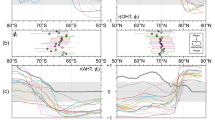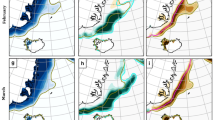Abstract
The sea ice-covered polar oceans have received wider attention recently for two reasons. Firstly, the global conveyor belt circulation of the ocean is believed to be forced in the North and South Atlantic through deep water formation, which to a large degree is controlled by the variations of the sea ice margin and especially by the sea ice export to lower latitudes. Secondly, CO2 response experiments with coupled climate models show an enhanced warming in polar regions for increased concentrations of atmospheric greenhouse gases. Whether this large response in high latitudes is due to real physical feedback processes or to unrealistic simplifications of the sea ice model component remains to be determined. Coupled climate models generally use thermodynamic sea ice models or sea ice models with oversimplified dynamics schemes. Realistic dynamic-thermodynamic sea ice models are presently implemented only at a few modeling centers. Sensitivity experiments with thermodynamic and dynamic-thermodynamic sea ice models show that the more sophisticated models are less sensitive to perturbations of the atmospheric and oceanic boundary conditions. Because of the importance of the role of sea ice in mediating between atmosphere and ocean an improved representation of sea ice in global climate models is required. This paper discusses present sea ice modeling as well as the sensitivity of the sea ice cover to changes in the atmospheric boundary conditions. These numerical experiments indicate that the sea ice follows a smooth response function: sea ice thickness and export change by 2% of the mean value per 1 Wm-2 change of the radiative forcing.
Similar content being viewed by others
References
Ebert, E.E. and Curry, J.A.: 1993, ‘An intermediate one-dimensional thermodynamic sea ice model for investigating ice-atmosphere interactions’, Journal of Geophysical Research 98, 10085-10109.
Flato, G.M. and Hibler III, W.D.: 1992, ‘Modelling pack ice as a cavitating fluid’, Journal of Physical Oceanography 22, 626-651.
Harder, M.: 1997, ‘Roughness, age and drift trajectories of sea ice in large-scale simulations and their use in model verifications’, Annals of Glaciology 25, 237-240.
Harder, M., Lemke, P. and Hilmer, M.: 1998, ‘Simulation of sea ice transport through Fram Strait: Natural variability and sensitivity to forcing’, Journal of Geophysical Research 103, 5595-5606.
Hibler III, W.D.: 1979, ‘A dynamic thermodynamic sea ice model’, Journal of Physical Oceanography 9, 815-845.
Hibler III, W.D. and Zhang, J.: 1993, ‘Interannual and climatic characteristics of an ice-ocean circulation model’, in W.R. Peltier (ed.), Ice and the Climate System, NATO ASI Ser., Ser. I., Global and Environmental Change, vol. 12, Springer-Verlag, New York, pp. 633-652.
Hilmer, M., Harder, M. and Lemke, P.: 1998: ‘Sea ice transport: A highly variable link between Arctic and North Atlantic’, Geophysical Research Letters 25, 3359-3362.
Ip, C.F., Hibler III, W.D. and Flato, G.M.: 1991, ‘On the effect of rheology on seasonal sea ice simulations’, Annals of Glaciology 15, 17-25.
IPCC (Intergovernmental Panel on Climate Change): 1996, Climate Change 1995: The science of climate change, Contribution of Working Group I to the Second Assessment Report, Cambridge University Press, Cambridge, UK.
Kreyscher, M., Harder, M. and Lemke, P.: 1997, ‘First results of the Sea Ice Model Intercomparison Project (SIMIP)’, Annals of Glaciology 25, 8-11.
Lemke, P., Owens, W.B. and Hibler III, W.D.: 1990, ‘A coupled sea ice-mixed layer-pycnocline model for the Weddell Sea’, Journal of Geophysical Research 95, 9513-9525.
Lemke, P., Hibler III, W.D., Flato, G.M., Harder, M. and Kreyscher, M.: 1997, ‘On the improvement of sea ice models for climate simulations: the Sea Ice Model Intercomparison Project (SIMIP)’, Annals of Glaciology 25, 183-187.
Owens, W.B. and Lemke, P.: 1990, ‘Sensitivity studies with a sea ice-mixed layer-pycnocline model in the Weddell Sea’, Journal of Geophysical Research 95, 9527-9538.
Vinje, T., Nordlund, N. and Kvambekk, Å.: 1998, ‘Monitoring ice thickness in Fram Strait’, Journal of Geophysical Research 103, 10437-10449.
Vowinckel, E. and Orvig, S.: 1970, ‘The climate of the North Polar Basin’, in S. Orvig (ed.), Climates of the polar regions: World Survey of Climatology, 14, New York, pp. 129-252.
Author information
Authors and Affiliations
Rights and permissions
About this article
Cite this article
Lemke, P., Harder, M. & Hilmer, M. The Response of Arctic Sea Ice to Global Change. Climatic Change 46, 277–287 (2000). https://doi.org/10.1023/A:1005695109752
Issue Date:
DOI: https://doi.org/10.1023/A:1005695109752




